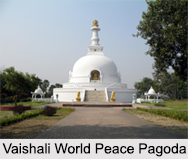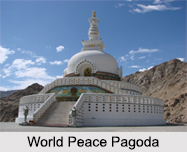 Peace Pagoda in Vaishali was constructed by Japanese Buddhists according to the teachings of Saddharma Pundarika Sutra to disseminate love and peace on earth. The third Peace Pagoda of the country or "Vishwa Shanti Stupa" is located in Vaishali, an ancient and archeological city of Bihar. The pagoda was completed on 23rd October in the year 1996 by the second Buddhist council. A Peace Pagoda is a Buddhist stupa, which was constructed for the sake of peace, love and happiness among people of all races and creeds. Vaishali was an important city in the life of Gautama Buddha.
Peace Pagoda in Vaishali was constructed by Japanese Buddhists according to the teachings of Saddharma Pundarika Sutra to disseminate love and peace on earth. The third Peace Pagoda of the country or "Vishwa Shanti Stupa" is located in Vaishali, an ancient and archeological city of Bihar. The pagoda was completed on 23rd October in the year 1996 by the second Buddhist council. A Peace Pagoda is a Buddhist stupa, which was constructed for the sake of peace, love and happiness among people of all races and creeds. Vaishali was an important city in the life of Gautama Buddha.
History of Peace Pagoda
Most of the Peace Pagodas have been built under the guidance of Nichidatsu Fujii; he was a Buddhist Monk from Japan and the founder of the Nipponzan-Myohoji Buddhist Order. Fujii was greatly inspired meeting Mahatma Gandhi in 1931 and decided to devote his life in promoting non-violence all over the world. In 1947, he began constructing Peace Pagodas as shrines for the sake of world peace.
 Structure of Vaishali World Peace Pagoda
Structure of Vaishali World Peace Pagoda
Vaishali Peace Pagoda is 125 feet in height and 118 feet in width with a dome of 65 feet. The Pagoda enshrines the holy relics of Lord Buddha on the base and on the top of the construction. The top portion of the stupa houses Lord Buddha"s statues. The statues are made of glass and fiber and have been polished with gold. Vaishali Peace Pagoda was constructed under the guidance of Nakasato, one of the disciples of Fujii Guruji.
Visiting Information to Vaishali World Peace Pagoda
Peace Pagoda at Vaishali is located near the Coronation Park. Goraul railway station and Gaya airport are the nearest to Vaishali. Vaishali can also be reached by road via National Highway 19.
This article is a stub. You can enrich by adding more information to it. Send your Write Up to content@indianetzone.com



















